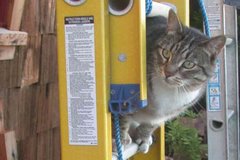Tuesday, November 15, 2016
Long Day and Deserved Sunset
<H2>2016.11.15</H2>
<H2>Long Day and Deserved Sunset</H2>
<ul>
<li>Last night was a stormy night with relatively high seas, so we all awakened with a low battery. I had several strange dreams. In one of them, I had a rental car stolen. I kept forgetting to call it in to the police. Eventually, late in the day, I was at the store purchasing some wine. The person selling me the wine asked me for my birthdate. Then they covered up part of the label on the wine bottle and asked me my name (strange dream). I told her my name and she asked me if I had a car stolen. When I said yes, she handed me the phone and I spoke to the police. They asked me which cars I had ever owned, one by one. In another dream I visited a friend Lisa Fitchett (Kato) and she had torn off her entire roof to her house. It was about to rain and all of her belongings were still on the wall (it was her parent's house, somewhere on the side of a mountain). She did not seem to care
that they would all be ruined by the rain. </li>
<li>Needless to say, everyone seemed to be a little tired all day today. There was also a feeling that seemed aligned with the disaster that had just taken place back at home. People chatted about how their family and friends were coping with the earthquake. Tourists were being helicoptered out of the region. I have been hearing some of the details from the geologists responding to this event. They have been on helicopter rides making initial assessments… The estimate from offset roads and the like is that the main strike-slip fault (the Kekerengu fault) ruptured in this earthquake slipped 8-9 meters!!! There have been observations of offsets on at least two other strike-slip faults, as well as inferred offset on a thrust fault that links some of the strike-slip faults. The ruptures are very complex and we will learn a tremendous deal about how faults interact with each other during
earthquakes like this. This is a major offset and the teams will be hitting the ground as soon as the roads open up. The helicopters are too busy helping people to spare any for science (at least, that is what we presume given the time delay on getting their boots on the ground. We are making plans on what we might do to make observations from the ship in relation to this earthquake. We are talking about where to take cores to find a probable turbidite, as well as possibly conducting some high resolution bathymetric surveys to look for fault offsets in the sea floor! This is really exciting!!!</li>
<li>We have continued to collect cores in excellent locations. There have been many turbidites in our cores. Some are sandy and easily seen. These can be identified by color changes as well as textural changes (the background sediment, hemipelagic sediment, is basically mud or "very fine sandy silt;" while these turbidites are sandy or "very fine to very coarse sand"). However, with my experience in Cascadia, Sumatra, and the Lesser Antilles, we have been able to identify some muddy turbidites that are only visible with color changes. Basically, the background hemipelagic sediment is lighter in color (probably due to nano fossil content) and the muddy turbidites are darker in color. Also, the turbidites often have a sharp basal contact, while the hemipelagic sediment has a gradual basal contact. I will try to post some photos of these examples later. </li>
<li>We are collecting X-Ray data while on board the ship. When we compare the X-Ray data with our lithologic logs, there is an excellent match. We have been able to capture most of the turbidites (even the muddy ones). Eventually the cores will be CT-scanned for higher resolution X-Ray data. Also, the cores will have core geophysical data collected (magnetic susceptibility, density, etc.). These additional data sets will be key for further stratigraphic correlation analysis. </li>
<li>These cores that we have collected promise to be excellent candidates to develop an earthquake story for the subduction zone here. This will take several years to be sure… But, we have turbidites, within each core, they appear to have unique structures (important for correlation!). The biggest challenge I see is obtaining sufficient mass of planktonic foraminifera to be able to get radiocarbon ages. Time will tell (pun intended). </li>
<li>Attached to this post is a sunset from tonight, Monique on the left and Jamie on the right. We sure deserved this after all the long days that we have been putting in. Now, it is time to catch up on some rest for another long day tomorrow. I am so lucky to be on this ship. Also, I am so very excited to work with an excellent science and ship's crew. Everyone is top notch. </li>
<li>I also include some other photos from a post from a couple days ago. We are cutting a core in the van in one photo. The piston corer is being recovered onto the ship in another. Jenny is cleaning a cone in one. More photos to come!</li>
</ul>
Subscribe to:
Post Comments (Atom)







No comments:
Post a Comment